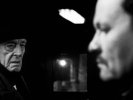Eye For Film >> Movies >> The Man From London (2007) Film Review
When you were a kid, did you ever hear the phrase, "You'll understand when you're older"?
This weighty, grinding, almost intimidatingly lugubrious film from iconic filmmaker Béla Tarr may make you cringe in your seat as if it is all just too awful to understand.

The Man From London is interminable hours of the most hauntingly composed black and white photography you could see for a long time. There's slow symbolism dense enough to sink the Titanic. You'd beg them to crank the movie faster, but daren't in case it's a masterpiece. As a stylistic exercise it leaves you gasping, but working it all out is another matter. There's a Wagnerian majesty to it. A dignity that defies intellectual comprehension. At least until it has had time to sink in at a deeper level.
The opening shot made me think of that boat that ferried the dead across the River Styx. We see the hull of the ship. It is drained of colour and sunlight. Eventually waves of darkness drift down across the screen like eyelids closing. We are forced to contemplate it. The shimmer of lamplight on the damp dockside. Looking out through the lattice squares of a window, train lines frame the noirish scene. Low key lighting and oblique angles evoke a sense of dread.
We have panned back to take in more of the ship in the desolate jetty. This could be somewhere in Eastern Europe. Somewhere you pull your coat collar around you tight to keep out the damp, dank feelings permeating everything. Somewhere you'd rather not be alone.
Diagonal foreground lines of an overcoat collar intersect our view. We look over the shoulder of someone (Maloin) watching the scene below. There, men dressed in black woollen overcoats and hats. Only their faces highlighted. Steam issuing from between the wheels of a waiting train. A wordless conspiracy over a suitcase. Feel the cold, clammy atmosphere of undetermined threat.
The Man from London proceeds not at the speed of hell freezing over. More like a hell frozen over long ago and never to thaw. Ever. A place from which there is no escape. A god-forsaken wasteland.
The plot, what there is of it, is taken from a story by Simenon. It involves the discovery of a suitcase of money that railway switchman Maolin fishes out of the drink. The corpse comes later. The dosh was stolen. But the mystery, while satisfyingly concluded in its own good time, is little more than a pretext. Enigmatic justice dispensed by a police inspector takes our mind off to unexpected pathways. Hope, hopelessness, redemption (and without any simplistic religious overtones). Justice and humanity. But the real power of the film is in its formalist rejection of cinematic convention. There is a plot, but it is not plot-driven. The landscape, the bare-furnished rooms, are all protagonists, as much as the sullen and uncommunicative characters.
The cinematography cuts the air like a Baltic ice-axe and supports the film's main theses. We first see Tilda Swinton, Maloin's wife, almost as a hidden part of this surly man's own persona. The camera pans up slowly from behind Maloin, revealing her slight figure as she sits opposite him. In another scene, she goes to the window and is totally engulfed by sunshine for a brief second until she closes the shutters to let him sleep. Inside Maolin and his humdrum existence is hope for dignity, for something better. But it seems so unlikely that he can barely face the possibility. Precisely focused shots draw attention to tiny, grimy detail (often further enhanced by use of 'chiaroscuro' deep-shadows lighting). The grain of wood or the lines on skin, or even fingernails. We feel Maloin's almost invincible acceptance of his lot at a painfully deep level.
Compositions have the breathtaking precision and deliberateness of such Tarkovsky masterpieces as Andrei Rublev, but with the megalithic slowness that is one of Tarr's trademarks.
Apart from forcing us to contemplate much more deeply than we are used to in a world of fast-moving, CGI-enhanced cinema, the slowing-down reveals other interesting effects. In one scene, there is a long, unmoving head-shot of the murderer's wife under questioning. She says nothing for several minutes, but we see the gradual build-up of emotion in her features (the scene is reminiscent of Andy Warhol's Screen Tests, which are fortuitously exhibiting in the Edinburgh Festival at the same time as the UK premiere of The Man From London).
The forlorn beauty of The Man From London might inspire you to question the assumptions we make about cinema, instilling a deeper appreciation of the aesthetic possibilities of this wondrous art form. Or you may leave disenchanted, claiming that, however wonderful the characterisation and deep-stage photography exhibition might be, it seems rather less than the sum of its parts. Either way, the coldness of the atmosphere will have eaten into you to such an extent that you long for a bowl of hot soup or a mug of warming coffee. Your body wants to escape the implacable struggles and silences, the constant dirge-like accordion, the austere minimalism, and dialogue designed as much for its audio qualities as its content. And if you do, I hope, like me, you will look back and treasure what you might almost dismiss.
Reviewed on: 15 Aug 2007


















